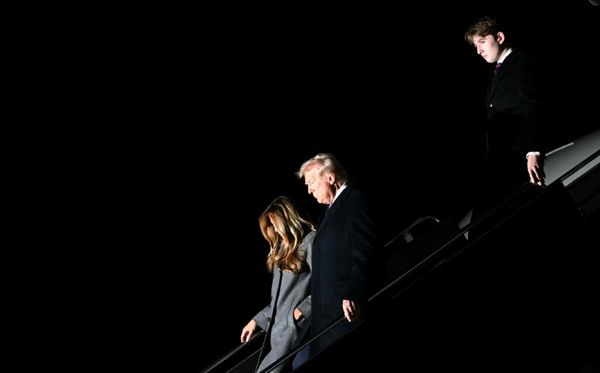
This is part three in a series. For the full series, go here.
The US Defence Department could have no greater friend than Australia’s own Richard Marles, who has become the political gift that keeps on giving.
Midway through last year, barely two months after taking office, the defence minister publicly endorsed what has become the holy grail of US defence operations: moving from a relationship of “interoperability” with its close allies to a state of “interchangeability”.
Marles made the commitment at a speech he gave under the approving gaze of diplomats and military types at prominent Washington think tank, the Centre for Strategic and International Studies.
“We are making big investments in defence capital infrastructure to support, maintain and sustain the growing number of Australian and American forces. We will operationalise a regular presence and an increased exercise tempo,” Marles said, before adding the killer lines everyone wanted to hear: “We will move beyond interoperability to interchangeability. And we will ensure we have all the enablers in place to operate seamlessly together, at speed.”
To the untrained ear, interoperability and interchangeability might seem to be a distinction without a difference. But if you know the code it means something else entirely.
Moving from interoperability to interchangeability with close allies, including Australia and the UK, has been a pet project of United States Chief of Naval Operations Admiral Mike Gilday for several years. Put simply, “interchangeability” fully blurs the lines between different military forces by using common equipment, which in turn may mean a common industrial base.
Admiral Gilday reinforced his push earlier this year, telling a gathering of military, business and academic figures at the US Surface Navy Association conference that “we are trying to entice our high-end partners to go beyond interoperability into interchangeability”.
“It’s a push to put us in a position where, if we do have to fight tonight, we’re not stumbling.”
Gilday listed several examples where international navies were approaching interchangeability. These included the US taking operational control of international aircraft carriers in the US European Command in late 2022. US allies were also part of a US defence-wide data sharing project, Project Overmatch, and were purchasing “relevant equipment”.
Marles’ overt endorsement of the US Navy’s aims received scant coverage at the time outside specialist defence media.
Writing in The Australian Financial Review, Sydney University’s James Curran said Marles’ rhetoric on “interchangeability” with US forces went to the heart of a debate that ought to be had in Australia about policy flexibility and autonomy in the age of AUKUS. He said that it recalled a prediction made in 2016 by former ambassador to the US Kim Beazley that “in the next five years the Americans are going to talk about integration”.
What does it mean for Australian sovereignty?
Allan Gyngell, a former director-general of the Australian Office of National Assessments, founding executive director of the Lowy Institute, and one-time foreign policy adviser to the Keating government, said Marles’ use of the terms interoperability and interchangeability “certainly complicates the debate about sovereignty”.
“Both ‘interoperability’ and ‘interchangeability’ imply that the equipment can be used automatically in the defence operations of either country without backward reference,” Gyngell told Crikey.
Hugh White, emeritus professor at ANU’s Strategic and Defence Studies Centre and a former senior official in the Department of Defence, said he was “very struck” by the formulation used by Marles in his speech to the Centre for Strategic and International Studies.
“It conveys a fundamental shift in the basis of Australia’s decisions about how we invest in defence,” he wrote in an email to Crikey. “When we abandoned ‘forward defence’ in the 1970s — after Vietnam — we moved to a policy of building our armed forces specifically to defend Australia independently, rather than designing them to fight alongside our allies.”
This was not an abandonment of the idea that Australia would fight alongside our allies, he said, rather that we counted on the forces “we designed for our own defence” to contribute to US-led coalitions if and when required within limits.
“Marles’ words in his CSIS speech — especially his talk of ‘moving beyond interoperability’ and of making ‘big investments’ to ‘support, maintain and sustain’ US as well as Australian forces — is the strongest statement we have seen that the old post-Vietnam defence of Australia focus … has been abandoned in favour of a policy to design, build and invest in our forces specifically to support American forces in US-led coalition operations,” White said.
“This is, quite literally and unambiguously, a return to forward defence.”
White acknowledged that Marles didn’t initiate the shift, which had been underway “since the mid-2000s” but had accelerated sharply recently, especially after the Morrison government’s defence strategic update in 2020.
Another important message in Marles’ speech, White said, was his talk of “capital infrastructure” to allow Australia and the US to operate together, as it suggests Australia would spend money “not just to exercise but to ‘operate’ — conduct combat operations — from Australian soil”, something which had not happened “since WW2”.
“It contrasts with Marles’ insistence elsewhere that the Labor policy of no foreign military bases on our soil remains inviolate,” White said, adding that this shift began with former prime minister Julia Gillard agreeing to US Marine rotations through Darwin in 2011.
Are these policy shifts a good idea? White said that depends on whether you think closer alignment with US strategy and objectives in Asia — and especially in relation to China — is “the best way for Australia to navigate the dangerous decades ahead”. Regardless, such a big shift in defence policy has been undertaken without “frank debate and acknowledgement”, he said.
Crikey sought comment from Marles’ office on the question of interchangeability but received no reply.
Are you concerned about Australia being drawn further into the military orbit of the US? Let us know by writing to letters@crikey.com.au. Please include your full name to be considered for publication. We reserve the right to edit for length and clarity.







